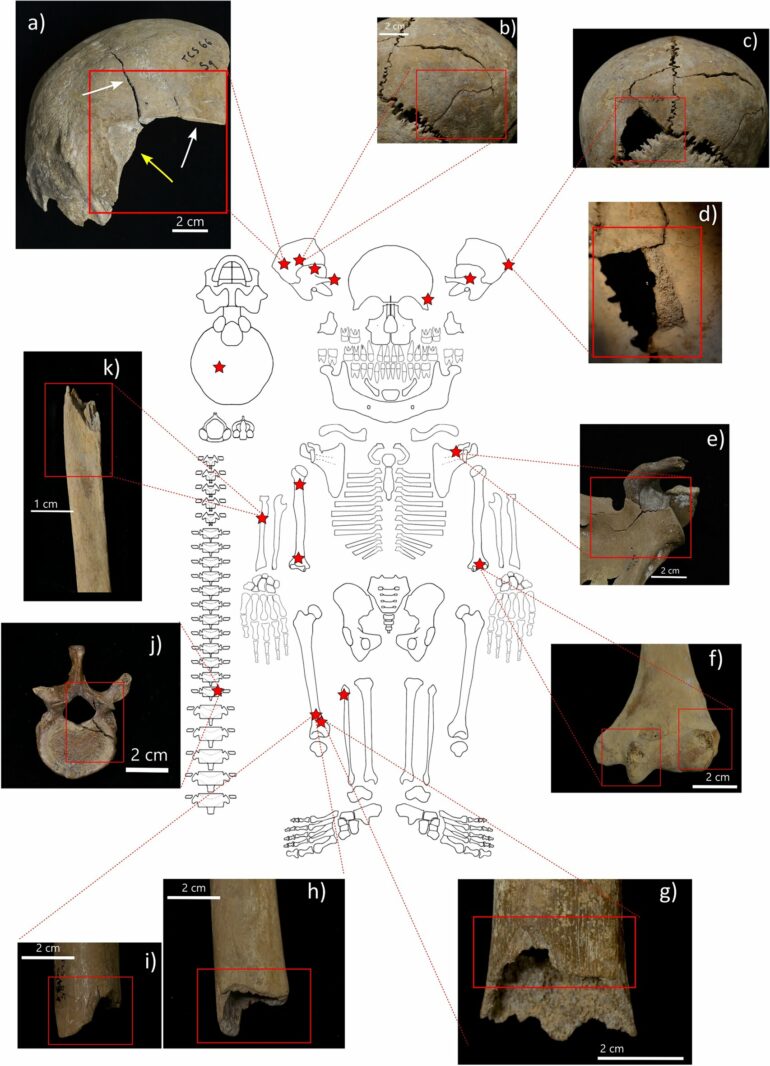Archaeologists have been investigating human bones found near the ruins of a bridge in the Three Lakes region of Switzerland. They seek not only to discover what took place, but also to better understand the Celtic heritage of the region.
A jumble of bones, skulls and wood beams was recovered on the bed of a river. What happened, and who were the individuals found there? The ruins of the Celtic bridge at Cornaux/Les Sauges and the 20 skeletons found nearby have been the subject of speculation ever since their discovery in 1965 during renovations of the Thielle Canal.
Specialists in archaeology, anthropology, thanatology, biochemistry and genetics have now revisited the case. The conclusions of their study have been published in the journal Scientific Reports.
The sudden accident theory prevails
This study is part of a joint international project conducted by the University of Bern and the Eurac Research Institute for Mummy Studies in Bolzano, which aims to enhance our understanding of the Celts in Switzerland and northern Italy. The Celts’ predominantly oral culture has left limited written sources, and much of what is available comes from the writings of Julius Caesar.
“They are the stories of a military adversary, so they are not necessarily objective and complete,” says Zita Laffranchi, a postdoctoral fellow in the Institute of Forensic Medicine at the University of Bern. “By focusing on the archaeological finds, we are able to give a voice to the people who are not attested in the written record.”
Together with her colleagues, the researcher conducted a bioarchaeological investigation to try to reconstruct the drama that once took place in Cornaux/Les Sauges.
The ruins of the Celtic bridge and the skeletons are indeed controversial. For some, a sudden flood or tsunami led to the collapse of the wooden structure. For others, the corpses were the victims of human sacrifice, an attested Celtic practice often associated with water.
The skeletons were examined from every angle to attempt to reconstruct the circumstances of the drama. Their state of preservation and the remarkable presence of brain fragments in five of the skulls suggest that sediment covered the corpses not long after death. The remains preserve multiple bone lesions spread across the bodies, from the skulls to the legs.
They appear to have been caused by violent impact. No injuries that would have been intentional or caused by sharp objects were identified, in contrast to analytical results at other European sites where sacrifices are attested. These elements, plus the fact that some of the bones were entangled with pieces of wood, point to an accidental event. The theory that a tsunami caused the collapse of the bridge therefore seems likely.
Multiple waves of deaths possible
This is not the only information that the skeletons have delivered. Some of the bones and teeth have also been the subject of chemical analysis. Radiocarbon dating can provide a date range to understand when an individual lived, while other isotopic analyses can provide information on the victims’ diet and places of residence. Finally, paleogenetic analyses allowed the research team to analyze the ancient DNA from half of the individuals.
After making the bones ‘speak’ in this way, scientists can confirm the presence of at least 20 people, with no apparent family link between them: a young girl, two other children, and 17 adults—most of whom were young, and 15 of whom appear to have been men.
This clear demographic bias, with a strong majority of young adult men, could correspond to a group of prisoners or slaves who were sacrificed or to a convoy of merchants or soldiers. Finally, since some radiocarbon dates have proved ambiguous, it is impossible to be certain that all the deaths took place at the same time and that they coincided with the destruction of the bridge.
“Considering all these elements, it is very likely that a violent and sudden accident took place in Cornaux,” summarizes Marco Milella, researcher at the University of Bern and co-leader of this project.
“But this bridge had a prior life. It may have been a place of sacrifice, and it is conceivable that some corpses preceded the accident. There is no reason to choose between the two alternatives.”
The exact sequence of events of the Celtic bridge at Cornaux/Les Sauges will thus probably remain a mystery. “In this type of research, we are interested in individuals. We trace their life stories, which can be emotional,” says Laffranchi. “But at its root, the goal is to better understand our cultural and biological heritage, at the level of the population.”
At the heart of Celtic Europe
The Three Lakes region was important to the Celts, especially the Helvetians (Helvetii), the largest Celtic tribe that settled in the area between Lake Geneva and Lake Constance. This new study, the first to use paleogenomics for the analysis of Celtic individuals from Switzerland, confirms their genetic proximity to other Iron Age populations.
For instance, some of the lineages identified in Cornaux have been found in Britain, the Czech Republic, Spain and central Italy. Isotopic analyses indicate that some individuals may have grown up in the Three Lakes region and others in the Alps.
These discoveries confirm the importance of the region at the time and corroborate the increasingly well-substantiated notion of a mixed population and high mobility among the Celtic groups. Far from being isolated by the mountains surrounding them, our Helvetian ancestors already lived at a busy crossroads at the center of Europe.
More information:
Zita Laffranchi et al, Geographic origin, ancestry, and death circumstances at the Cornaux/Les Sauges Iron Age bridge, Switzerland, Scientific Reports (2024). DOI: 10.1038/s41598-024-62524-y
Provided by
Schweizerischer Nationalfonds SNF
Citation:
Victims of a tsunami or human sacrifice? What happened to 20 Celts 2,000 years ago? (2024, June 17)



